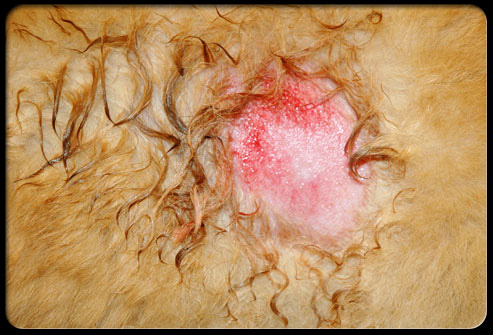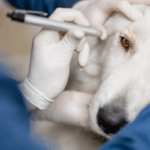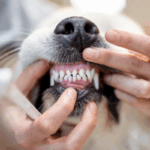A Hot Spot is the common term for an area of skin that suddenly becomes a “hot” area of intense licking or scratching. It is produced by self-induced trauma as the dog bites, rubs, or scratches at a part of its body in an attempt to alleviate some pain or itch.
What does it look like?
A typical lesion is red, moist and oozing smelly fluid. The hair is lost from the area, but the margins are sharply defined from the surrounding normal skin and hair. A normal skin bacteria called Staphylococcus intermedius is usually present in high numbers in the lesion.
If there are new multiple smaller red spots spreading into the skin around the main lesion this is termed “folliculitis”. Folliculitis indicates there is a deeper bacterial infection that will require a longer course of antibiotic tablets.
Which breeds are most commonly affected and why?
Breeds with a heavy coat, particularly a dense undercoat, are most commonly affected, such as Golden Retrievers, Labrador Retrievers, Collies, German Shepherds, Rottweillers and St. Bernards. The problem is much more common in hot, humid weather and may have something to do with lack of ventilation in the coat. These breeds may also be prone to skin allergies.
What are likely causes of this type of skin irritation?
Scratching or biting is the cause of the infection however this happens secondary to an irritation. Underlying causes include:
- environmental factors such as hot humid weather, a wet coat, contact with irritant substances
- skin allergies (In dogs, skin allergies can be caused by fleas, inhaled allergens, or foods)
- ear infections can cause some dogs to scratch at the side of their faces below the ear
- other external parasites such as mange mite are occasionally involved
It seemed to come on so quickly, Why?
The above factors initiate the “itch-scratch” cycle, which varies in intensity in individuals. The intense trauma can produce large, severe lesions in a only few hours.
How is the condition treated?
Therapy is effective if applied promptly and vigorously:
- Sedation or anaesthesia is usually required to allow thorough clipping and cleansing of the area.
- A topical cream containing local anaesthetic, cortisone and antibiotic is usually applied.
- Injections of cortisone and antibiotics are often given immediately, followed by a course of tablets to take home after the procedure. Revisits as requested by the vet are essential to ensure the lesion heals fully as occasionally longer courses of medication are required.
Is my dog contagious to me or other pets?
No. All dogs, cats, and people have Staphylococci living on the skin as a normal resident.
How can I prevent this from happening again?
There is no simple method of prevention. However, constant attention to grooming, hygiene, baths and parasite control and periodic cleansing of the ears may help. Bathing regularly with a medicated antibacterial shampoo can help to keep skin bacterial numbers down. Make sure your pet receives regular flea control.
Owners should be particularly vigilant during periods of hot, humid weather. If your pet gets wet during humid weather, then ensure he or she is rinsed in clean fresh water and thoroughly dried as quickly and effectively as possible. After bathing, do not replace the neck collar until the coat is completely dry to touch.
Applying a gentle ear cleaner to the ears immediately after bathing may reduce ear irritation and minimize the risk of ear infections and potential hot spots on the face.
If your pet has any ongoing symptoms that may be attributable to skin allergy, then please see one of our vets to discuss this possibility in further detail






